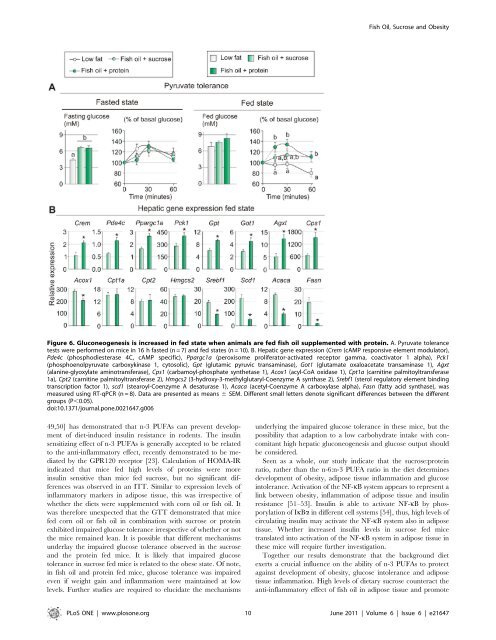The obesogenic effects of polyunsaturated fatty acids are dependent ...
The obesogenic effects of polyunsaturated fatty acids are dependent ...
The obesogenic effects of polyunsaturated fatty acids are dependent ...
Create successful ePaper yourself
Turn your PDF publications into a flip-book with our unique Google optimized e-Paper software.
Fish Oil, Sucrose and Obesity<br />
Figure 6. Gluconeogenesis is increased in fed state when animals <strong>are</strong> fed fish oil supplemented with protein. A. Pyruvate tolerance<br />
tests were performed on mice in 16 h fasted (n = 7) and fed states (n = 10). B. Hepatic gene expression (Crem (cAMP responsive element modulator),<br />
Pde4c (phosphodiesterase 4C, cAMP specific), Ppargc1a (peroxisome proliferator-activated receptor gamma, coactivator 1 alpha), Pck1<br />
(phosphoenolpyruvate carboxykinase 1, cytosolic), Gpt (glutamic pyruvic transaminase), Got1 (glutamate oxaloacetate transaminase 1), Agxt<br />
(alanine-glyoxylate aminotransferase), Cps1 (carbamoyl-phosphate synthetase 1), Acox1 (acyl-CoA oxidase 1), Cpt1a (carnitine palmitoyltransferase<br />
1a), Cpt2 (carnitine palmitoyltransferase 2), Hmgcs2 (3-hydroxy-3-methylglutaryl-Coenzyme A synthase 2), Srebf1 (sterol regulatory element binding<br />
transcription factor 1), scd1 (stearoyl-Coenzyme A desaturase 1), Acaca (acetyl-Coenzyme A carboxylase alpha), Fasn (<strong>fatty</strong> acid synthase), was<br />
measured using RT-qPCR (n = 8). Data <strong>are</strong> presented as means 6 SEM. Different small letters denote significant differences between the different<br />
groups (P,0.05).<br />
doi:10.1371/journal.pone.0021647.g006<br />
49,50] has demonstrated that n-3 PUFAs can prevent development<br />
<strong>of</strong> diet-induced insulin resistance in rodents. <strong>The</strong> insulin<br />
sensitizing effect <strong>of</strong> n-3 PUFAs is generally accepted to be related<br />
to the anti-inflammatory effect, recently demonstrated to be mediated<br />
by the GPR120 receptor [23]. Calculation <strong>of</strong> HOMA-IR<br />
indicated that mice fed high levels <strong>of</strong> proteins were more<br />
insulin sensitive than mice fed sucrose, but no significant differences<br />
was observed in an ITT. Similar to expression levels <strong>of</strong><br />
inflammatory markers in adipose tissue, this was irrespective <strong>of</strong><br />
whether the diets were supplemented with corn oil or fish oil. It<br />
was therefore unexpected that the GTT demonstrated that mice<br />
fed corn oil or fish oil in combination with sucrose or protein<br />
exhibited impaired glucose tolerance irrespective <strong>of</strong> whether or not<br />
the mice remained lean. It is possible that different mechanisms<br />
underlay the impaired glucose tolerance observed in the sucrose<br />
and the protein fed mice. It is likely that impaired glucose<br />
tolerance in sucrose fed mice is related to the obese state. Of note,<br />
in fish oil and protein fed mice, glucose tolerance was impaired<br />
even if weight gain and inflammation were maintained at low<br />
levels. Further studies <strong>are</strong> required to elucidate the mechanisms<br />
underlying the impaired glucose tolerance in these mice, but the<br />
possibility that adaption to a low carbohydrate intake with concomitant<br />
high hepatic gluconeogenesis and glucose output should<br />
be considered.<br />
Seen as a whole, our study indicate that the sucrose:protein<br />
ratio, rather than the n-6:n-3 PUFA ratio in the diet determines<br />
development <strong>of</strong> obesity, adipose tissue inflammation and glucose<br />
intolerance. Activation <strong>of</strong> the NF-kB system appears to represent a<br />
link between obesity, inflammation <strong>of</strong> adipose tissue and insulin<br />
resistance [51–53]. Insulin is able to activate NF-kB by phosporylation<br />
<strong>of</strong> IkBa in different cell systems [54], thus, high levels <strong>of</strong><br />
circulating insulin may activate the NF-kB system also in adipose<br />
tissue. Whether increased insulin levels in sucrose fed mice<br />
translated into activation <strong>of</strong> the NF-kB system in adipose tissue in<br />
these mice will require further investigation.<br />
Together our results demonstrate that the background diet<br />
exerts a crucial influence on the ability <strong>of</strong> n-3 PUFAs to protect<br />
against development <strong>of</strong> obesity, glucose intolerance and adipose<br />
tissue inflammation. High levels <strong>of</strong> dietary sucrose counteract the<br />
anti-inflammatory effect <strong>of</strong> fish oil in adipose tissue and promote<br />
PLoS ONE | www.plosone.org 10 June 2011 | Volume 6 | Issue 6 | e21647
















